Mongolia: In the Footsteps of Genghis Khan, Part 3: Fine Arts, Winter Palace, Dinosaurs, Folk Dance & Music Show |
This image gallery covers the third part of our July, 2007, trip to Mongolia (for the second part click here). In this part we visit several interesting museums in Ulaanbaatar, and see a performance by the State Folk Dance and Music Ensemble. |
| |
The Zanabazar Museum of Fine Arts in Ulaanbaatar is Mongolia's primary repository of national historical and modern arts. |
|
Deer Stone Monument (modern copy) |
|
|
Stone Man, Turkish period (6th-7th c. AD) |
|
|
|
|
|
|
Earthenware Mask, Kharkhorin (13th-14th c. AD) |
|
|
Sita Tara (White Tara), of gilt bronze, by sculptor Zanabazar himself (17th c. AD) |
|
|
| |
|
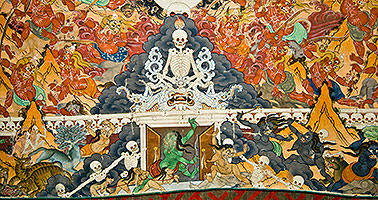 |
These are Thangka (scroll paintings on cloth) from the 19th century. Each represents a Buddhist deity. Monks could roll these up and easily store them or carry them to use in other ceremonies or at other monasteries. This art form originated in Nepal and came to Mongolia by way of Tibet.
Left, a detail from the Begtse Darmapala.
|
|
| The Offerings for Mahakala (applique, silk thread, 19th century). Two details below. |
|
|
| Mandala /Kalachakra/ (applique, 19th century, silk thread) (detail below)
Mandalas are the perfected environments of the Buddha's, built on the foundation of their perfect wisdom. |
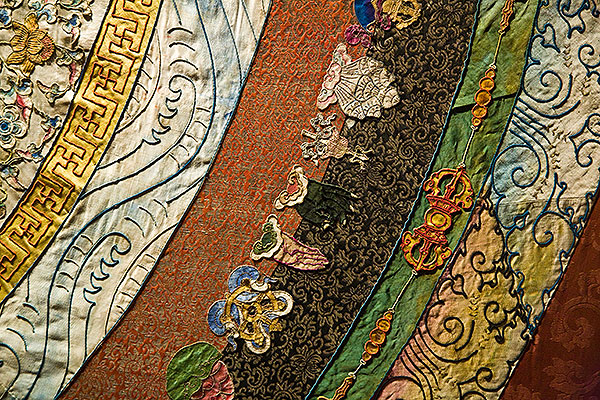 |
| |
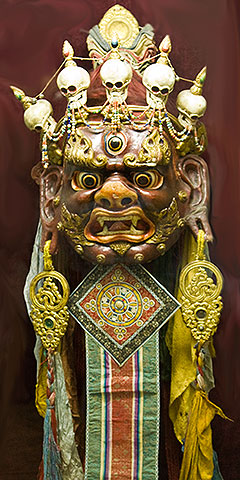 |
Khuree Tsam:Tsam is a Buddhist ritual that came to Mongolia in the 18th century by way of India and Tibet. It was performed in Mongolia from 1811 to 1937, and is said to have reached its grandest form at Ikh Khuree (now Ulaanbaatar). Performers representing wrathful deities would wear elaborate costumes and masks such as these, and would perform dances to expel evil spirits and bring good fortune to the community. The scale of the productions made them as much performance art as religious rituals. The Tsam masks, as shown here, are made of paper mache inlaid with coral and other materials. These are 19th century originals, representing Takkiraja(left) and Vajrapani (right). |
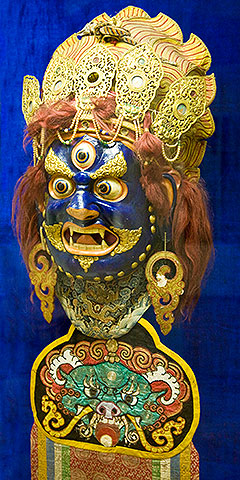 |
|
| |
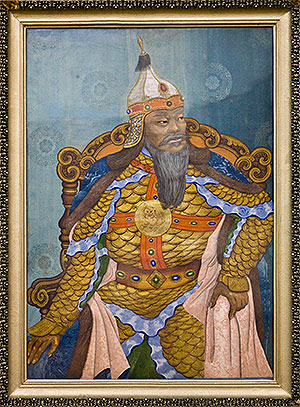 |
A complete lack of contemporaneous likenesses of Genghis Khan has not discouraged later artists from painting his portrait.
To the left is one by D. Manibadir (1956), while the one on the right is a copy of a 14th century portrait. |
 |
|
| |
 |
Also copies of 14th century portraits, these are of Genghis Khan's successors Ogedei Khan (left) and Khubilai Khan (right). |
 |
|
| |
| "One Day in Mongolia", an early 20th century painting by Balduu Sharav, is a collection of vignettes of daily life in Mongolia, some of them humorous, and others merely authentic. It is a very popular work, seen on posters and in shops all over Mongolia. |
| |
The Bogd Khan (1869-1924) was the last Kahn of Mongolia -- the last ruler to be enthroned on the basis of hereditary or religious identity. He became Khan (Emperor) in 1911, when the country declared independence from the Qing Dynasty of China. But the Chinese entered and occupied Mongolia in 1919, putting the Bogd Khan under house arrest. At his smuggled invitation a White Russian warlord (Baron Ungern von Sternberg) entered Mongolia and kicked the Chinese out, but then he proclaimed himself Emperor. A homegrown revolutionary, Damdin Sukhbaatar, with support from some Red Army units, managed to defeat Baron Ungern von Sternberg's forces and liberate Mongolia. The Bogd Khan was then allowed to cling to his title and token authority until his death in 1924, after which the communists declared that there would be no more khans.
The Winter Palace of the Bogd Khan in Ulaanbaatar is partly restored and open as a museum, exhibiting his religious objects and collections as well as the palace buildings and other elements of his lifestyle. Some of these are pictured below. |
|
|
|
| |
|
| |
|
|
| |
| Some restoration work is going on. |
| |
|
|
|
| |
|
| |
| A snow leopard-skin ger -- fit for a Khan. And transportation fit for a Khan, too (below). |
 |
| |
|
A toy ship the Bogd Khan played with as a child. |
|
|
Antarctic penguins the Bogd Khan collected as an adult. |
|
|
|
| |
The Natural History Museum is best known for its Hall of Paleontology, with impressive dinosaur fossils found in Mongolia. |
| |
| This is a Tarbosaur -- a giant flesh-eating dinosaur. The length of some Tarbosaurs may have been up to 14 meters, with an adult weight of 3-4 tons. This specimen and all of the dinosaurs below were found in the Southern Gobi, and they are from the Late Cretaceous Period, 70-80 million years ago. |
| |
| The herbivorous Saichania was a kind of armored dinosaur. |
| |
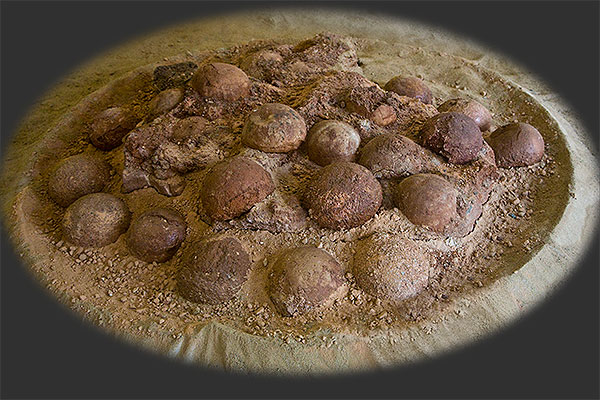 |
This dinosaur egg nest was found in 1994 in the South Gobi (Algui Ulan tsav). |
|
This pair of fighting dinosaurs is world famous for the rare view of dinosaur life it affords. It was discovered in the South Gobi in 1971. A carnivorous Velociraptor mongoliensis (right) has attacked a herbivorous Protoceratops andrewsi (left), with its claws in the Protoceratops' belly. The Protoceratops is fighting back, by clamping the Velociraptor's right arm in its jaws. The Velociraptor does appear to be feeling the pain. At this point it is believed that a collapsing sand dune or similar sudden event buried the two together and froze the moment in time. |
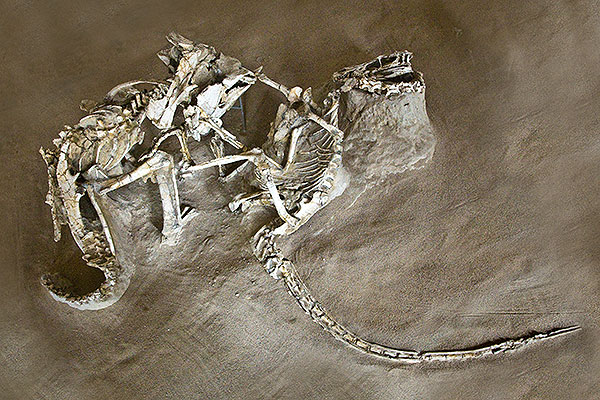 |
|
| This isn't a dinosaur at all. It is the skeleton of a a wooly rhinoceros (Coelodonta), which roamed the steppes of Eurasia in the Pleistocene Era, about 1.8 million years ago. These could be up to 12 feet in length. |
| |
The State Folk Dance and Music Ensemble performance at the National Drama Theater is an elaborate costumed show with traditional music and instruments, throat singing and acrobatics. |
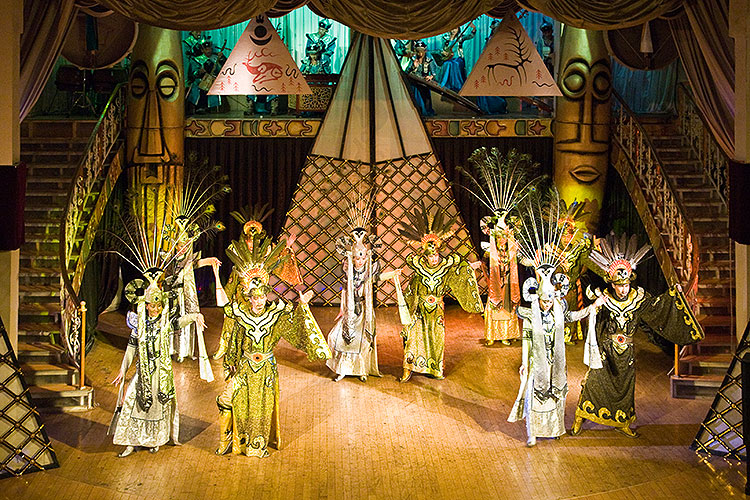 |
| |
|
| |
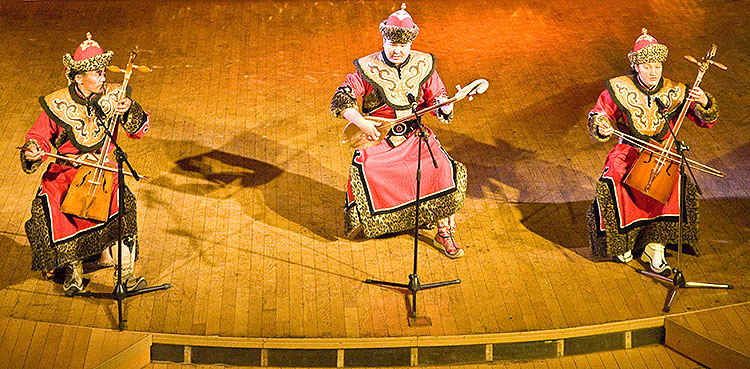 |
| |
|
| |
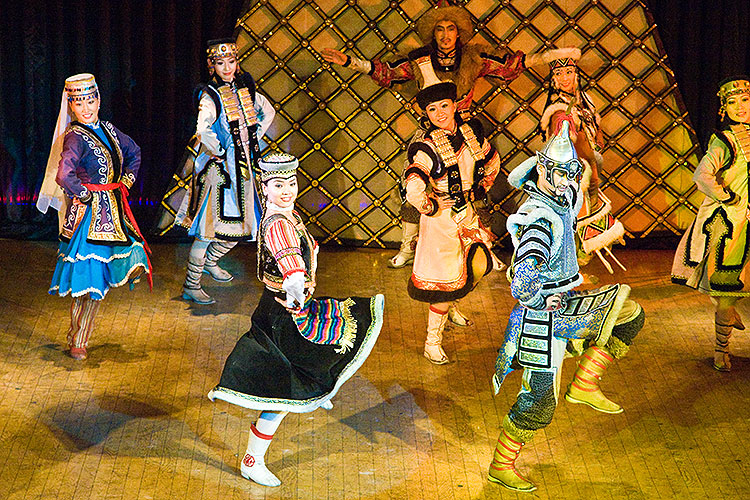 |
| |
 |
| |
| |
| This concludes the third part of our visit to Mongolia. For the fourth part, click here. |